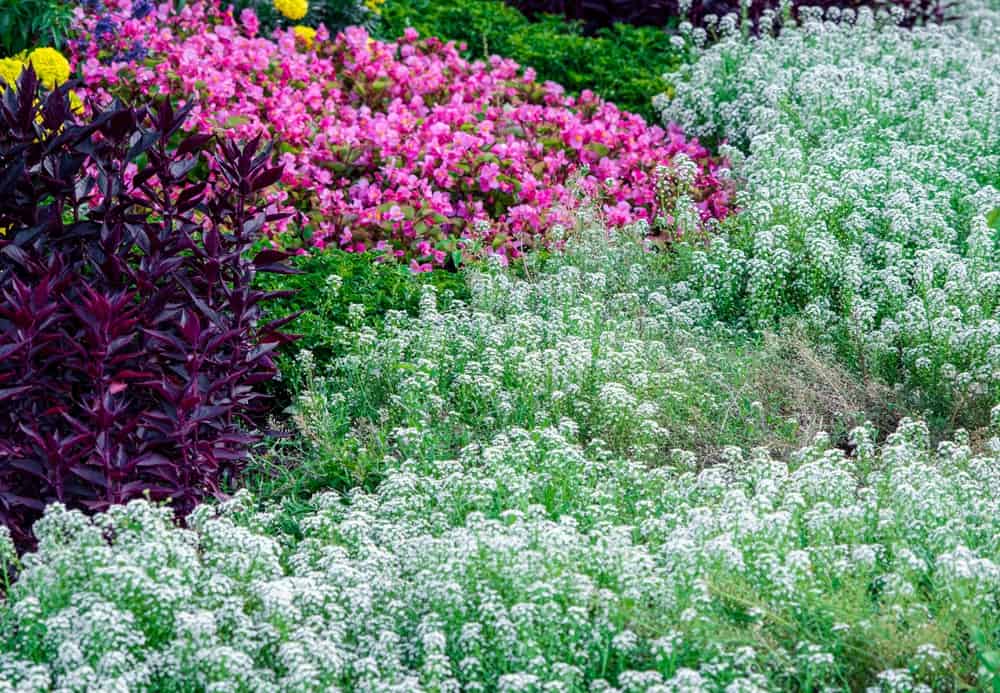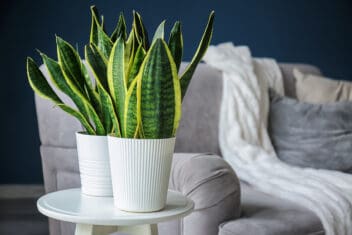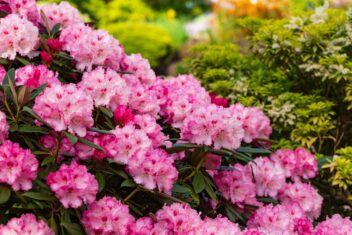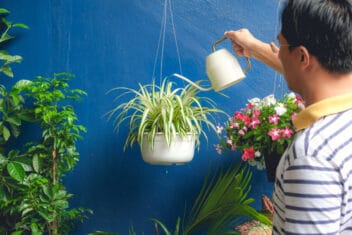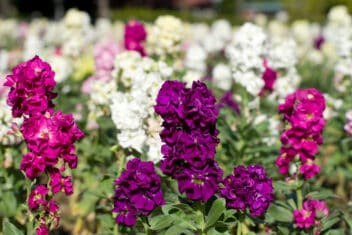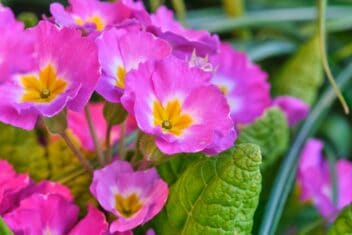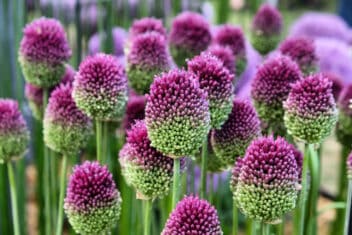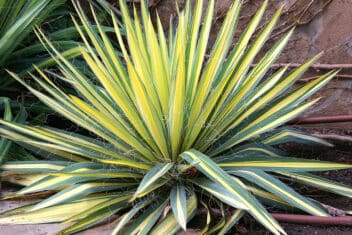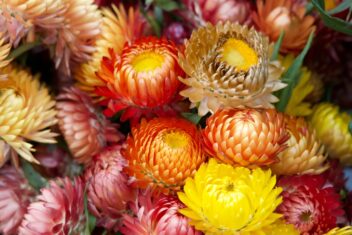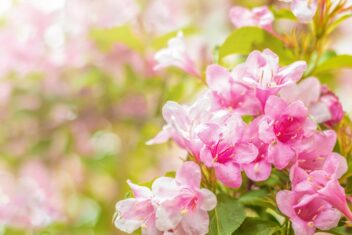From borders, pots, vegetable, and rock gardens, to pathways and battling weeds in difficult areas, sweet alyssum is an excellent option.
This flowering annual may be small in stature but packs a punch once it’s established with carpets of color wherever you plant it. Despite being an annual, it self-seeds readily and will return year after year.
Alyssum brings heaps of benefits to the garden and is an easy-grow plant that can be enjoyed spring through fall.
What is Sweet Alyssum?
Sweet alyssum (Lobularia maritima) is also known as sweet Alison, carpet flower, or just alyssum. It is part of the Brassicaceae family, which includes approximately 350 genera and around 3,700 species of plants.
Incredible to think this blooming marvel of a plant is the cousin to broccoli, mustard, kohlrabi, cauliflower, cabbage, Brussels sprouts, radish, and kale.
Like many plant species, alyssum has been cultivated and hybridized to promote the more desired characteristics of the original plants found in the Mediterranean back in the 1500s.

When comparing the blooms of the Brassicaceae family, it’s clear to see the family resemblance. Brassicas are often called “crucifers” or “cruciferous” due to the cross-like forms of the four petals and sepals, which sweet alyssum has.
Sweet alyssum has strong self-seeding properties and spreads readily, making it potentially invasive in some areas. It’s considered invasive in coastal regions of California.
Categorized as an annual, it can also be a short-lived perennial. The leaves and flowers are edible.
The Benefits of Planting Sweet Alyssum
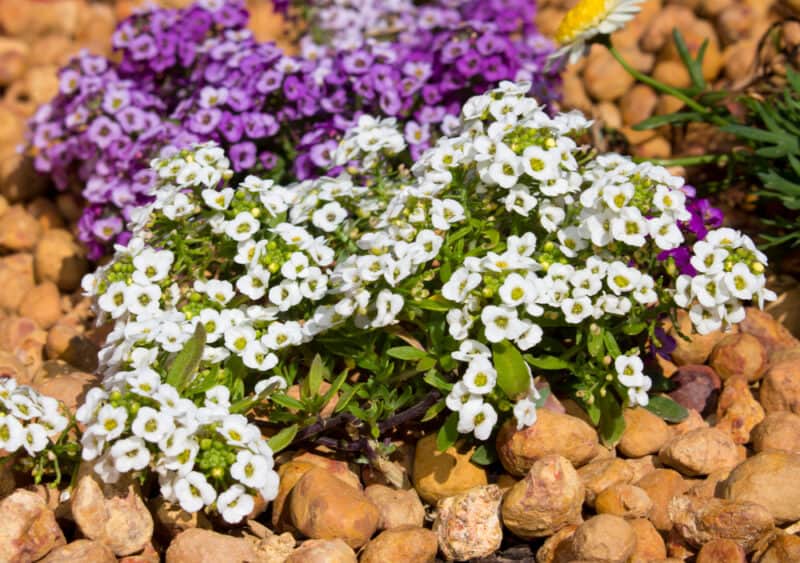
Alyssum can be an excellent companion plant due to its attractiveness to beneficial insects. Hover flies (family Syrphidae), parasitoid wasps, ladybugs (family Coccinellidae), and minute pirate bugs (Orius spp.) all love it. Alyssum is also popular with bees and butterflies.
It’s a great tool in the combat of pests such as caterpillars, aphids, thrips, beetles, scale, sawflies, mealybugs, and psyllids.
This wonder plant attracts a particularly unwanted member of the insect world, the bagrada bug (Bagrada hilaris), a stink bug that targets Brassicaceae plants. If this bug goes unchecked, it can cause a lot of problems. Alyssum can be used as a trap crop in the battle against this bug.
As a bonus, this groundcover is deer and rabbit resistant.
Not only are alyssum flowers edible, but they have been used medicinally for centuries. They’re often used in homeopathic remedies to combat colds, coughs, stomach pains, and fluid retention.
Chickens are also a fan of this plant, which is worth bearing in mind if your chickens are free-range and you choose to grow this plant.
Don’t confuse sweet alyssums with basket of gold alyssum (Alyssum saxatile). They look somewhat similar, but they’re totally different plants.
Top 10 Types of Alyssum
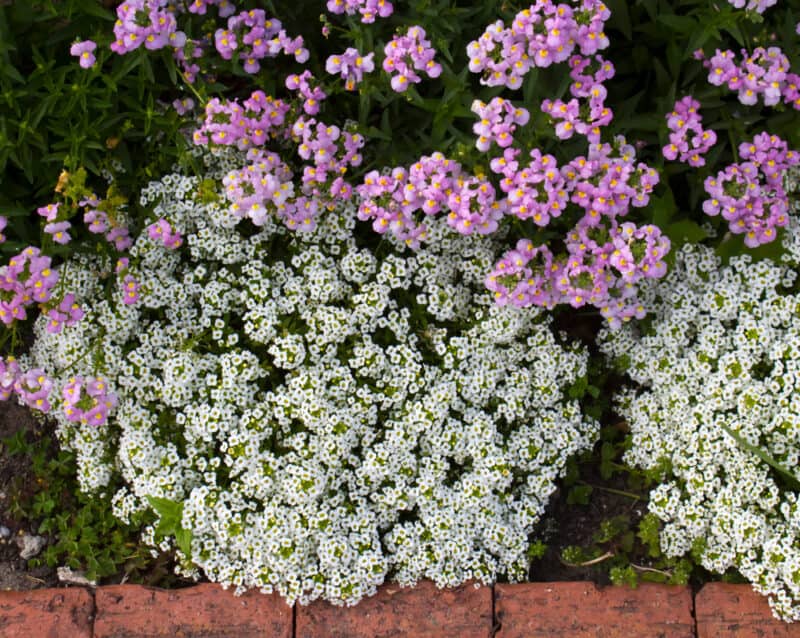
There are many options on the market, and you’re sure to find a few at your local nursery. Here are a few of our favorites:
Lavender Stream
‘Lavender Stream’ has bundles of flowing lavender-colored blooms with a deep green foliage backdrop. Reaching eight inches tall and spreading up to 36 inches wide at maturity, it makes an eye-catching groundcover.
It’s an excellent cultivar for containers, raised beds, and baskets as it has a trailing growth pattern. Position it in full sun or partial shade, and keep the soil moist, particularly in hanging baskets.
Hardy in USDA Hardiness Zones 3-9.
Easter Bonnet
‘East Bonnet’ has pink, purple, and white flowers.
A compact grower, it has an early flowering habit and reaches 6-8 inches spread and height. It’s compact growth makes it ideal for weed suppression and as an edging plant in borders.
Position in full sun or partial shade, free draining soil, and keep moist to encourage growth and plant health. Grow in Zones 9-11.
Allure Pastel Blend
If unable to choose a color or wanting numerous shades, ‘Allure Pastel Blend’ has you covered. As the name suggests, this is a blended pallet of pastel whites, yellows, pinks, peach, and purples.
This is a small flowering, compact alyssum reaching just 2-4 inches in height and 6-12 inches in diameter.
As a low grower, it’s a suitable one to add texture to part-shaded areas of the garden in Zones 5-9, and is well suited for vegetable gardens as it won’t drown out other plants.
Snow Princess
One for those with a drier, hotter climate, ‘Snow Princess’ thrives in warm areas with full sun in Zones 9-11. It has much larger, white flowers than the traditional alyssum cultivars.
Known for its fragrance, ‘Snow Princess’ grows to six inches in height and spreads to a healthy 60 inches.
This hybrid is sterile, so it’s a good option if you want to avoid the self-seeding, invasive tendencies of other alyssums. It’s a winner for attracting pollinators such as butterflies and bees. Since it doesn’t put energy into developing seeds, it blooms longer.
Dwarf Pink
One of the shortest cultivars of alyssum, hence the name, ‘Pink Dwarf’ makes a great addition to pathways, rock gardens, and tightly spaced areas.
This pink blend often offers a two-tone flower head of pinky-purple with the odd white blossom. It reaches just 2-4 inches tall and about a foot wide.
One of the more versatile alyssum in terms of suitable growing regions, it will grow in Zone 3-12.
Carpet of Snow
‘Carpet of Snow’ has honey-scented, petite, white blossoms. It reaches 4-6 inches in height and up to 12 inches wide in Zones 5-9.
Royal Carpet
‘Royal Carpet’ has flowers with extremely vibrant hues of magenta, violet, and fuchsia. With its bright coloring and vigorous growth, it has a big impact.
An all-rounder for pots, baskets, tiny spaces, hard-to-grow areas, this is the ultimate set-it-and-forget-it option. It grows larger than some of the alyssum listed here, coming in at 6-12 inches in height and 12-18 inches wide.
Grow in Zone 7-9.
Pastel Carpet
Similar to ‘Royal Carpet,’ but in dreamy, soft hues of rose, pink, violet, blue, white, apricot, and a creamy-yellow. This cultivar blooms in abundance, and, at times, it’s hard to see any foliage for blossoms.
This stupendous ground cover will help suppress weeds in your garden beds. It grows to 3-9 inches in height with a 10-12 inch spread.
This easy keeper likes a cooler climate with free-draining soil, but it’s adaptable. Plant it in Zones 3-11.
Snow Crystals
Heat, wind, and somewhat frost tolerant, this sweet alyssum covers the ground with its dense growth, suppressing any weeds.
While ‘Snow Crystals’ prefers full sun positions with moderate moisture, it’s able to deal with some shade as long as it has at least six hours of sun a day.
Grows in Zones 9-11 to between 6-10 inches in height and 12-14 inches spread once fully grown.
Red Queen
Want a red carpet in the garden to welcome visitors? This is the one to choose. It has velvet, three-toned flowers in cream, pink, and deep red.
It offers flowers all summer in the right conditions, which include six or more hours of sun and moderate, consistent moisture. It also must be planted in free-draining soil.
It’s a prolific re-seeder, reaching heights of 4-10 inches, with a 10-48 inch spread in Zones 3-11.
How to Grow Alyssum from Seed
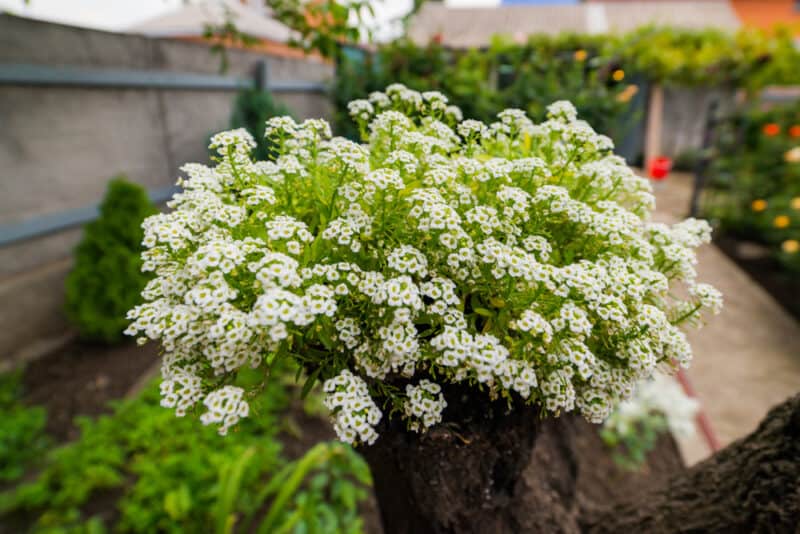
Growing sweet alyssum from seed is quick and easy. If you live in Zones 7 and lower, start seeds indoors about six weeks before the last predicted frost date. If you’re in warmer Zones, plant alyssum directly in the ground or outdoor containers in early spring.
In seed trays filled with seed starter mix, sprinkle a few seeds on top of the soil. Best to use multi-celled pots so that roots aren’t too disturbed when you come to plant out.
If you’re direct sowing outdoors, sprinkle the seeds in place. Don’t cover them with soil; they need light to germinate.
Use a misting spray to keep the soil moist but not overly damp. Seeds will rot quickly if they’re overwatered. Seeds germinate two or three days after sowing if the conditions are right.
Nurture in seed trays until seedlings have strength and grow to approximately three inches tall. This means the root system will be well established for planting out.
Plant in position. If direct sown thin or move some seedlings to allow proper spread.
Alyssum will self-seed if left to mature. Over time, most will revert back to the standard white flower of the species.
Caring for Sweet Alyssum
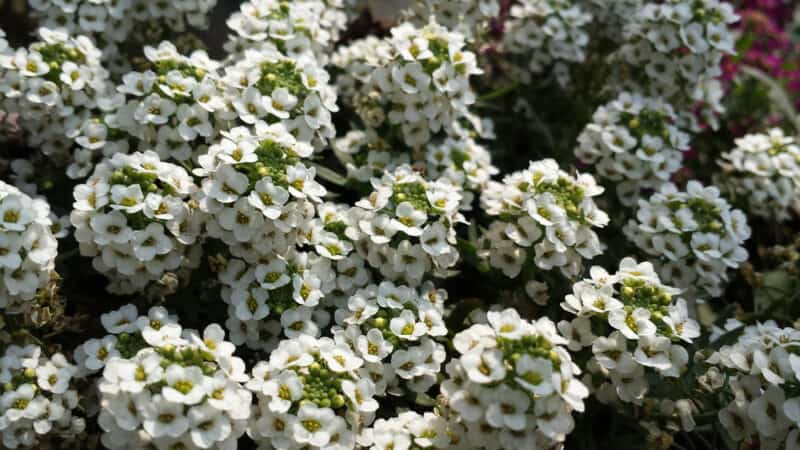
Most sweet alyssums need full sun and moist soil. Many will tolerate some dryness, however. If you live in a hot, dry region, some afternoon sun is a good idea. Above all, the soil must be well-draining.
As the plants age, they tend to die or split in the center. Pull out some of the stems to allow the clump to refresh.
As the blossoms appear and mature, the plant may struggle to push through new shoots, so a good cutback mid-season will help. If you don’t, the plant may become straggly and withered, allowing disease to set in.
Don’t fertilize these plants. They don’t need anything extra and too much fertilizer will encourage the leaves to grow at the expense of the flowers.
Pests, Problems, and Solutions
Alyssum is pretty robust and is relatively maintenance-free for the home gardener. So long as you plant in well-draining soil with good air circulation, it’s unlikely that you’ll encounter issues.
Trouble comes for alyssum if its roots are too wet; it really thrives on free-draining soil types and moist conditions that don’t mean it’s constantly sitting in water.
However, sweet alyssum isn’t immune to issues. There are a few things to watch out for:
Diseases
If a disease strikes your alyssum, it will probably be fungal. Since most fungi thrive in moisture, the best way to avoid these is to keep your plants well-watered but not wet and try not to water on the leaves.
If you do water on the leaves, do it in the morning so the foliage has time to dry. Here are the issues to look for:
- Root rot
- Wilt
- Damping off (Rhizoctonia solani)
- Botrytis blight (gray mold)
- Downy mildew (Hyaloperonospora parasitica)
- Stem and crown rot
- Powdery mildew
Most fungal issues can be treated using copper fungicide.
Pests
- Cyclamen mite
- Aphids
- Bagranda bug
- Caterpillars
Bug-wise if the Alyssum plant is healthy and attracts natural predators, there isn’t too much to worry about regarding aphids and caterpillars. If the damage isn’t too profound, spray the plants with neem oil or just let them be.
